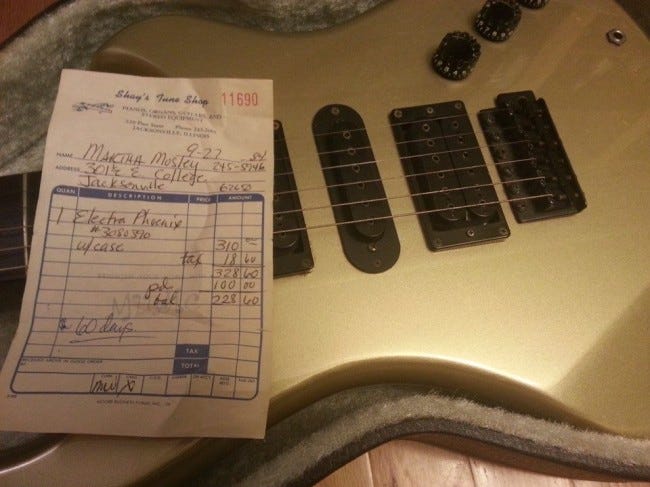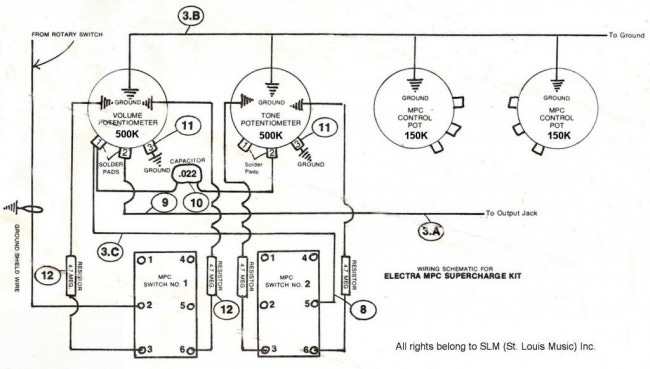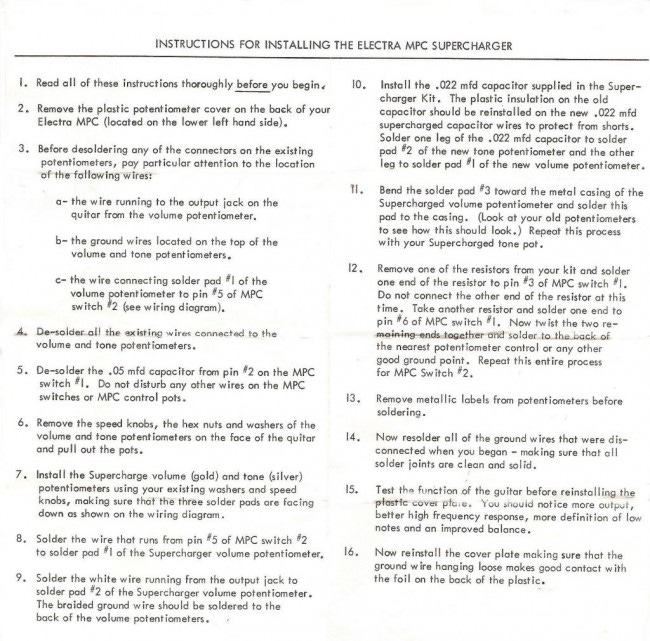The Electra, The Receipt, The Supercharger, The Eastern Star

It's the purchase of which every guitar collector dreams: the owner drags it from under the bed and apologizes for the condition, but only the strings are rusty. The rest of it is virtually untouched. The strings might be original, even. And there's a receipt from a small-town music store, complete with serial number and evidence of a $100 layaway payment.
Of course, the dream usually includes a 1959 Les Paul, not a 1983 Electra X185SS. I'm now the owner of three "Silverstone" (meaning "gold") X185 models from 1983. Supposedly, they are rare, and indeed I've bought every one I've ever seen for sale. There's something odd about them, however:
The Electra Phoenix X185 and it's twin, the Westone Spectrum GT, was very much the working man's super-strat, selling for considerably less than the Electra X199/Spectrum FX. They were extremely popular. After all, these were the Van Halen Years and Kramer was the best-selling guitar brand in America. The vast majority of the X185s I see are the Guards Red X185R, with heavy fretwear and a full complement of dings. I'm no longer buying those and I've sold all but one of the ones I did have. Which reminds me to tell the story some time of a guy who said he really needed one as a player, so I sold him the absolute best one I had for a song... only to have him dump it on Craigslist the following week. I suppose I've just told that story. Fuck that guy.
The X185SS, on the other end, appears to have attracted a different kind of owner. All three of mine are in near-perfect condition, with two of them being good enough to hang on the wall of a Guitar Center and represent as brand-new. (Collectors know that "Guitar Center Wall New" is a recognized grade of guitar condition, something less than "New" but better than "Player Grade".) Was it the color? Gold wasn't a young man's color in 1983, not for guitars. Was it the relative rarity that attracted a more patient buyer? Was it the EVH factor? The other colors tend to be beat up as well, it's not just the red ones.
Regardless, if you ever need to buy an Electra superstrat sight unseen, the X185SS is your best bet. One of mine came with a relative rarity in Electra-world: the Supercharger kit.

Note the Phoenix stickers on the knobs. The X185 debuted the Tom Presley eighteen-way pickups, but players who wanted even more tone could try the "Supercharger Kit". It consisted of a new volume pot, a new tone pot, and different capacitors.


Another brilliant idea from the mind of Tom Presley! I suppose it might be a good idea to do a tone demo with Supercharged and non-Supercharged variants of the X185SS. In fact, I'm going to do it. But, as Glen Hansard said, maybe not tonight. Tonight, I'll probably restring that X185SS I just got. Wrap the original strings up with the receipt. Daydream about who bought that guitar back in 1983 and what it meant to them. It was part of somebody's story, you know. But who knows now what that story was?
As it turns out, I can guess. The woman who purchased the guitar is now gone.
Martha E. Cook Mosley, 101 and 363 days, passed away Friday, July 6, 2012, in McHenry.
She was born July 9, 1910, east of Jacksonville, on the family farm. She was the daughter of Daniel and Sara Baker Cook. Martha married John H. Mosley in April 1940, and one daughter survives that union, JoAnn (the late Robert) Everett.
Grandma will be sadly missed by her grandsons, Scott and Andrew (Kimberly) Everett; and great-grandsons, Zachary Robert and Conner William Everett, whom she loved dearly.
Martha was preceded in death by her parents; three brothers, James Ralph, Joseph Raymond, and Daniel Cook; and one sister, Mable Irene James.
Martha loved her family and friends which she leaves many behind. She worked until she was 82 years young, walking to and from work every day. Martha was a member of the Centenary United Methodist Church and the Eastern Star.
Martha Mosley, you who were already seventy-three years old when you became an Electra owner, why did you buy it? Surely it wasn't a desire to become a shred guitarist, a Sister Rosetta Tharpe of the Eighties? Was it a gift? For a grandson who never took delivery of it? For a grandson who cherished it until he, himself, died and it was returned to you?
Given enough time, I could uncover the story. I could drive there, put on my earnest middle-class face, ask earnest middle-class questions. Then this guitar would have a complete story and not just my guesses.
Mrs. Mosley was a member of the Eastern Star. There's a woman out there somewhere, out of my own distant story, who wears her own grandmother's Eastern Star ring every day, it's her favorite piece of jewelry. Her second-favorite piece of jewelry is in her dresser, held against the day when she needs to sell it more than she needs to keep it. The Eastern Star itself is a fascinating organization, one hundred and seventy years old and thickly entwined with the mystery and the prosaic quotidian nature of Freemasonry. It values service.
Perhaps this guitar was an act of service, purchased in two installments in the hope that it would make a difference for a particular individual. It's worth a story. Perhaps I'll make the story up, publish it here, then go find out the real story. We'll see how close they are. My guess: the truth will be stranger than the fiction. Isn't that always how it goes? But how often do you read the phrase in fiction, meant to impart an illusion of truth?

